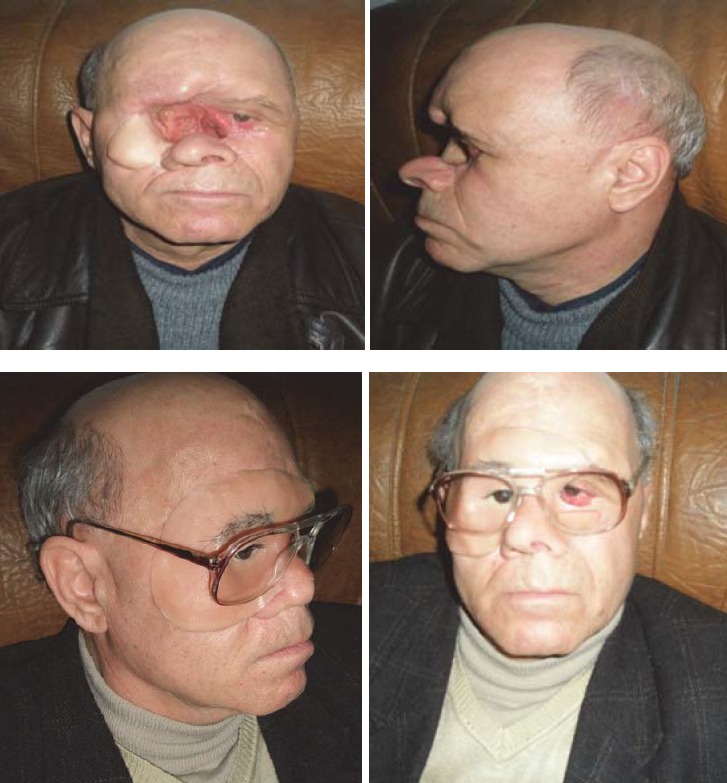Reconstructive surgery of the nasal pyramid
Author information
*“Prain” Medical Center, Bucharest, Romania
**“Carol Davila” University of Medicine and Pharmacy, Bucharest, Romania
***ENT Department, Colţea Clinical Hospital, Bucharest, Romania
Correspondence to: Lăţcan Elena, MD “Prain” Medical Center, 57 13 Septembrie Avenue, District 5, Bucharest, Romania Phone: + 4021 411 00 63; Mobile: +40 723 237 430; E-mail: or.nactal@anele
Abstract
The authors present their personal experience regarding the reconstruction of the nasal pyramid on 150 cases, encompassing both children and adults during the period 2000-2011.
Reconstruction of the nasal pyramid, regardless of age, was performed in cases of dysmorphias due to congenital malformations, accidents and surgical treatments with great loss of substance (benign or malignant tumors).
There were used the classical methods of reconstruction meaning rhino correction and rhinoplasty. However we mainly focused on the use of heterografts (implantable silicone implants – endoprostheses), or on the reconstruction of the nasal pyramid entirely with elastomeric silicone (epitheses), fixed with adhesive, implants and titanium magnets. Silicone, as a synthetic material, is very well tolerated by the body, having been demonstrated that it is a good oxygen carrier. Moreover, both nasal silicone and titanium implants are well tolerated as well and, in addition, they have good aesthetic, functional and psychological results. Patients regain an almost normal appearance, having good family and social integration and improved quality life.
Keywords: reconstruction, rhino correction, rhinoplasty, heterografts, silicone

B.I., 68 years old, Bucharest, right maxillary sinus cancer diagnosed 10 years ago, with invasion of the right orbit and eye, of the nasal pyramid , with numerous surgeries in the Buco-Maxillofacial Department and Plastic Surgery Department in Bucharest.
In 1999, the doctor suggested prosthetic reconstruction of the affected area (the half-upper right hemiface and eye orbit).In 2009, after unfavorable postoperative results, the patient required silicone reconstruction of almost 2/3 of his face.
References
References
1. Sarafoleanu C, Manea C, Neanu A, Postelnicu V. Bucuresti: Editura Academiei Romane; 2009. Atlas of Endoscopy in Otolaringology. [Google Scholar]
2. Florescu V, Florescu R. Editura Militara; 1986. Chirurgia Corectoare si Reparatorie a Nasului; pp. 28–36. [Google Scholar]
3. Garbea S, Moga I. Bucuresti: Editura Stiintifica si Enciclopedica; 1985. Rinologie-Patologia nasului si a sinusurilor paranazale. [Google Scholar]
4. Thomas KF. London: Quintessence; 1994. Prosthetic rehabilitation; pp. 25–32. [Google Scholar]5. Dumitru VA, Firica D. Bucuresti: Editura Didactica si Pedagogica; 1983. Chirugie ORL. [Google Scholar]
6. Aziz T, Watres M, Jagger R. Analysis of the properties of the silicon rubber maxillofacial prosthetic materials. J. Dent. 2003;31(1):67–74. [PubMed] [Google Scholar]
7. Branemark PI, DeOliveia MF. Carol Stream II: Quintessence; 1997. Craniofacial Prosthesis Anaplastology and osseointegration; pp. 78–79. [Google Scholar]8. Hemar P, Keller-Riedinger AM. 2009 Optimal Surgical Procedures Following Tumor Resection for Successful Prosthetic Rehabilitation by Means of Osseointegrated Craniofacial Implants, Desads, [Google Scholar]
9. Thomas KF. The art of clinical anaplstology. Orbital-hemi-facial defect. 2006:31. [Google Scholar]
10. Lang J. New York: Thieme; 1989. Clinical Anatomy of the Nose, Nasal cavity and Paranasal Cavity. [Google Scholar]11. Calarasu R, Ataman T, Zainea V. Bucuresti: Editura Universitara Carol Davila; 2000. Manual de patologie ORL; pp. 155–191. [Google Scholar]